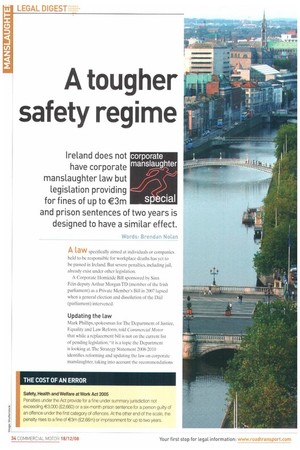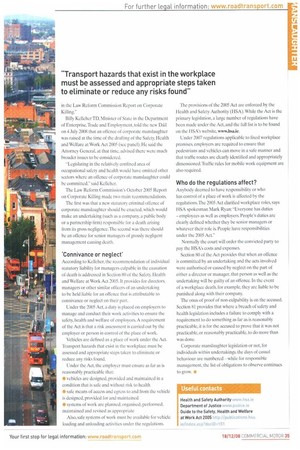A tougher safety regime
Page 34

Page 35

If you've noticed an error in this article please click here to report it so we can fix it.
Ireland does not have corporate manslaughter law but legislation providing for fines of up to €3m and prison sentences of two years is designed to have a similar effect.
Words: Brendan Nolan Alaw specifically aimed at individuals or companies held to be responsible for workplace deaths has yet to he passed in Ireland. But severe penalties, including jail, already exist under other legislation.
A Corporate Homicide Bill sponsored by Sinn Fein deputy Arthur Morgan TD (member of the Irish parliament) as a Private Member's Bill in 2007 lapsed when a general election and dissolution of the Dail (parliament) intervened.
Updating the law
Mark Phillips, spokesman for The Department of Justice, Equality and Law Reform, told Commercial Motor that while a replacement bill is not on the current list of pending legislation. 'it is a topic the Department is looking at. The Strategy Statement 2008-2010 identifies reforming and updating the law on corporate manslaughter. taking into account the recommendations in the Law Reform Commission Report on Corporate Killing."
Billy Kelleher TD, Minister of State in the Department of Enterprise,Trade and Employment, told the new Dail on 4 July 2008 that an offence of corporate manslaughter was raised at the time of the drafting of the Safety: Health and Welfare at Work Act 2005 (see panel). He said the Attorney General, at that time, advised there were much broader issues to be considered.
"Legislating in the relatively confined area of occupational safety and health would have omitted other sectors where an offence of corporate manslaughter could be committed," said Kelleher.
The Law Reform Commission's October 2005 Report on Corporate Killing made two main recommendations The first was that a new statutory criminal offence of corporate manslaughter should be enacted, which would make an undertaking (such as a company, a public body or a partnership firm) responsible for a death arising from its gross negligence The second was there should be an offence for senior managers of grossly negligent management causing death.
'Connivance or neglect'
According to Kelleher, the recommendation of individual statutory liability for managers culpable in the causation of death is addressed in Section 80 of the Safety. Health and Welfare at Work Act 2(X)5, It provides for directors, managers or other similar officers of an undertaking to be held liable for an offence that is attributable to connivance or neglect on their part.
Under the 2005 Act, a duty is placed on employers to manage and conduct their work activities to ensure the safety, health and welfare of employees. A. requirement of the Act is that a risk assessment is carried out by the employer or person in control of the place of work.
Vehicles are defined as a place of work under the Act. Transport hazards that exist in the workplace must be assessed and appropriate steps taken to eliminate or reduce any risks found.
Under the Act, the employer must ensure as far as is reasonably practicable that: • vehicles are designed, provided and maintained in a condition that is safe and without risk to health • safe means of access and egress to and from the vehicle is designed, provided for and maintained • systems of work are planned, organised, performed, maintained and revised as appropriate Also, safe systems of work must be available for vehicle loading and unloading activities under the regulations.
The provisions of the 2005 Act are enforced by the Health and Safety Authority (HSA).While the Act is the primary legislation, a large number of regulations have been made under the Act, and the full list is to be found on the HSA's website, www.hsale.
Under 2007 regulations applicable to fixed workplace premises, employers are required to ensure that pedestrians and vehicles can move in a safe manner and that traffic routes are clearly identified and appropriately dimensioned. Traffic rules for mobile work equipment are also required.
Who do the regulations affect?
Anybody deemed to have responsibility or who has control of a place of work is affected by the regulations.The 2005 Act clarified workplace roles, says HSA spokesman Mark Ryan: "Everyone has duties — employees as well as employers. People's duties are clearly defined whether they be senior managers or whatever their role is People have responsibilities under the 2005 Act."
Normally the court will order the convicted party to pay the HSA's costs and expenses.
Section 80 of the Act provides that when an offence is committed by an undertaking and the acts involved were authorised or caused by neglect on the part of either a director or manager, that person as well as the undertaking will be guilty of an offence. In the event of a workplace death, for example, they are liable to be punished along with their company.
The onus of proof of non-culpability is on the accused. Section 81 provides that where a breach of safety and health legislation includes a failure to comply with a requirement to do something as far as is reasonably practicable, it is for the accused to prove that it was not practicable, or reasonably practicable, to do more than was done.
Corporate manslaughter legislation or not, for individuals within undertakings. the days of casual behaviour are numbered — while for responsible management, the list of obligations to observe continues to grow.




































































































































































